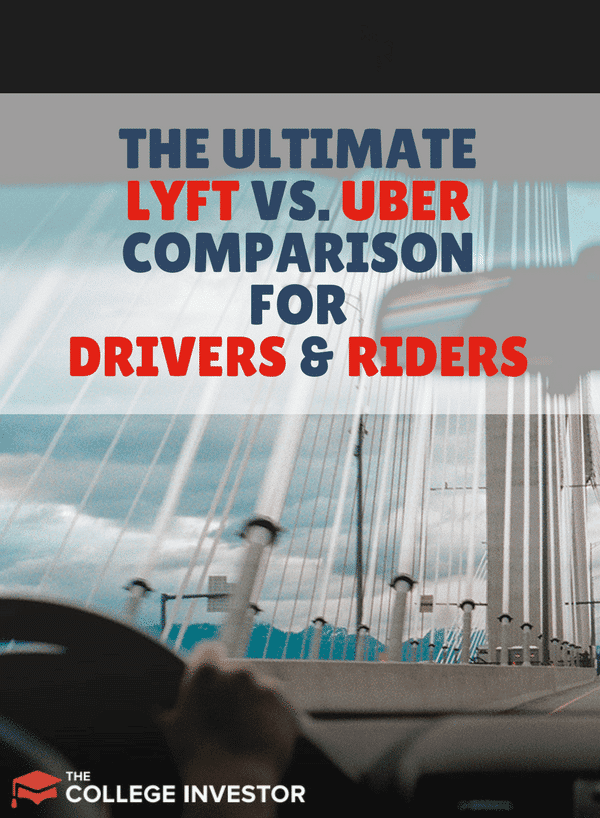
The taxi industry has suffered a huge loss by the increased popularity of rideshare apps, notably Lyft and Uber. I personally have been using these apps almost daily for about a year, and I love them. However, I'm shocked by how many people are still on the fence by these apps.
For riders, it can be strange to get "in someone else's car" the first time, but once you realize the convenience, you'll be hooked.
For drivers, it can be a great source of extra income that you can do on your own terms.
We have done an in-depth comparison for Uber and Lyft for Drivers and Riders.
Whether you’re a rider looking for a quick way to get downtown, or a driver looking to make extra cash for the holidays, we have all the information you need to help you make the right choice.
Riders
Whether its travelling or looking for a ride to the bar, most riders just want a safe, reliable and convenient option to get to their destination. Below, we will compare Uber and Lyft based on price, convenience, availability, and other amenities available for riders.
Lyft Promo: Sign Up to Lyft to ride using our link and get $10 in ride credits >>
Price/Other Charges
Both companies offer an account credit for getting started, but watch out for peak times, also known as surge times. Uber can increase the price up to 7x or 8x more than the original price, whereas Lyft increases their price by at least 2x the original amount. Lyft drivers are seeing an increasing surge of riders from Uber, increasing demand and inflating prices. Don’t worry; both companies will let you know the cost before you accept the ride.
With Uber and Lyft, the following factors will determine your ride fare:
Your City | Do you live in a large city of metropolitan area? |
Distance | Where are you traveling to, and how far is it from your place? |
Traffic | Are you located in or traveling to a high traffic area? |
Tip | How much are you planning to tip? |
To get an accurate estimate, check both apps to compare the rates before you request a ride. This way, you get the best deal on a specific trip. You can also compare rates through Fare Estimate. Just enter your starting point and destination, and you’ll see Uber and Lyft’s prices and available vehicle types.
The Uber app gives you a better idea of the total cost of your ride. Lyft is improving their app to be more transparent, but it’s still not quite there yet.
App/Ease of Use To Book Ride
Both apps are user-friendly and functional. Uber’s app appears to be more sleek and modern, with many features. You get to see when your driver will arrive at your pickup location and give them a rating after the trip. There’s not much difference, except for the fare estimate and interface.
Rating
Both apps require the rider to rate their experience and ask for feedback. Uber’s is notable because if you give your driver a 5-star rating, you get to give him a compliment and write a thank you note to recognize the driver’s exceptional service.
Uber’s app is not only full of features that let you book your ride and estimate your fare, it also allows users to tip their drivers. Lyft’s app is more vibrant, with fireworks going off in the app when a rider gives a good tip.
On the downside, the cross-promotion of other services such as UberEATS and other delivery services may be too noisy/create too many distractions for a rider who is just trying to quickly book a ride at a good price.
Availability In Areas
Although ridesharing options are popular in metropolitan areas, smaller towns are slowly catching on. Riders can expect to catch a ride from Uber anywhere they go, while Lyft is becoming more available in different cities.
While Lyft is slowly expanding, Uber has a higher coverage area than Lyft. Lyft is a great choice in times of high demand or when there is a driver nearby and you need a low cost ride fast. If you need a ride that looks good, Uber has a better selection of vehicles. If Uber is your choice, then you will pay less with UberPOOL.
Availability Of Vehicles
The most striking difference between Uber and Lyft is the variety of available vehicles.
Uber caters to businesspeople and professionals, and has a broad range of vehicles to choose from, including high-end luxury vehicles. Lyft also has higher quality vehicle options available, ranging from a Chevy Tahoe to a Maserati Quattroporte, but they are not as common as Uber LUX vehicles. Many of the Lyft Plus, Premier, and Lux vehicles are similar to the vehicles already included UberX and UberBLACK. To save time and money, decide on the vehicle you want, then do your research.
Vehicles Options For Uber
UberPool | This is the cheapest ride option available. Ride share rides go along the same route. |
|---|---|
UberX | Another budget option, everyday car for up to 4 people. |
Uber XL | An SUV with seating for up to 6 people. |
UberSELECT | 4-door luxury sedan dfor up to 4 passengers |
UberBLACK | High-end luxury vehicles with seating for up to 4 passengers |
UberSUV | The most expensive servicde Uber offers, a high-end SUV with seating for up to 6 passengers |
Vehicle Options For Lyft
Lyft Line | Riders share rides traveling the same route. This is the cheapest option for riders. |
|---|---|
Lyft | A regular vehicle that can accommodate up to 4 passengers, which is the cheapest option for not sharing a ride with strangers. |
Lyft Plus | A regular vehicle with room for up to 6 passengers |
Lyft Premier | Higher quality vehicles than other Lyft options with room for up to 4 passengers |
Customer Support For Riders
Both riders and drivers can reach customer service via email, in-app support, website support, and critical response lines. Riders have found Lyft to be a bit more helpful in solving problems. Uber has canned responses readily available on their Help Portal, while Lyft actually takes time to answer each question. In the rare event you need help, both apps will get you to your destination and answer your questions.
Brand Image
Uber’s image, heavily geared towards businesspeople, seems to be more high-end and prestigious. Overall, Uber offers a concise and professional business-like ride to your destination. The professionally dressed Uber driver will get out and open the door for the rider, help with bags, and overall, give the rider a full service experience.
On the other hand, Lyft tends to be playful and approachable, with a pink fluffy moustache display on the vehicle. Just as their slogan promises, Lyft is the equivalent of “Your Friend With a Car.” Lyft promotes an image of community and friendliness, which extends to how drivers are expected to interact with passengers.
Some drivers even participate in themed rides (examples include the Harry Potter theme and disco theme), while other drivers stick to the pink mustache theme. If you’re looking for a friendly ride with social interaction, Lyft is the perfect choice. Time will fly by as you sit in front seat and have a nice chat with your driver.
Recently, Uber has been the focal point for local and worldwide scandals, while Lyft has stayed out of the negative spotlight. As the number of scandals continues to rise for Uber, many riders are switching to Lyft. Expect to see more incentives and innovation from Uber as the company grows. Overall, Uber appeals to business riders who value luxury and prestige, while Lyft is geared towards more relaxed users simply looking for a friendly ride.
Drivers
It seems like almost everyone is either driving for Uber or Lyft after work to make some extra money. Some drivers even make a full-time income from driving for rideshare apps. Which one is better? Which one will make you the most money? Let’s take a look below.
Income and Other Opportunities
How Much Do Uber Drivers Make?
Let’s start with Uber. Uber offers lucrative signup bonuses of up to $500 if you complete 75 rides in 30 days.
Some Uber drivers have expressed dissatisfaction with pay, saying it was not worth the work, while others seemed content enough working for the ride-sharing company in conjunction with their other jobs.
It's important to note that it can be impossible to figure out individual pay for drivers per hour. It can vary so much - location, time, distance. And even the same drive each day can vary a little due to changing market conditions.
However, it can make decent money on the side, on your own terms.
With recent changes to the Uber board, the company is optimistic for better compensation schemes and increased driver flexibility.
If Uber sounds interesting, you can sign up here.
How Much Do Lyft Drivers Make?
Some drivers report bonuses anywhere from $500 to $5000 for Lyft, depending on location. Our advice? Be careful, and be sure to review Lyft’s terms for new driver promotions before jumping in.
According to a recent survey of close to 1200 drivers, rideshare platforms revealed that Lyft drivers averaged around $17.50 per hour, close to $2 more per hour than Uber drivers.
Lyft and Uber drivers earn approximately the same average per month, but the tips and earnings per trip are higher for Lyft.
Lyft drivers have the opportunity to earn a much larger amount of tips, while Uber just recently introduced in-app tipping features for passengers. Factors to consider include whether the driver is driving part-time, availability, and high demand cities.
A recent earnings data from Certify finds Lyft drivers to average $25.73 per hour.
Technology and loan company Earnest noted that Lyft drivers make slightly more than Uber drivers, with median earnings for a Lyft driver recorded at $210 per month and averaging $377, compared to $155 and averaging $364 for Uber.
However, the firm also noted that that Lyft drivers also drive for Uber, and vice versa.
Lyft drivers, if you are to go by all the survey results mentioned above, were higher paid, higher rated, and tended to be more satisfied than drivers of other popular transportation competitors.
Expenses also include vehicle upkeep. Factors like the type of car being driven, the city, age, driving record must also be factored in.
Full-time earnings (or driving from 45 to 50 hours a week) can reach around $800 with Lyft, according to some accounts.
The company has also been described positively for its startup environment and opportunity for growth.
Want to sign up for Lyft? Sign up and get started here.
Other Considerations
Expect to have some downtime between rides, especially if you live in a smaller town. Some drivers have reported only a few hundred dollars for a week of full time work. You can also expect your earnings to be affected by gas prices and maintenance costs. Also, the earnings vary by state. You can expect to be closer to the maximum hourly rate of $35 in cities like New York and Los Angeles.
Related: Check out these helpful apps for rideshare drivers.
Vehicle Requirements
Although the specifics will depend on the area you want to drive, Lyft and Uber have different standards. Uber requires a 2002 car model for most cities, whereas Lyft requires the driver’s vehicle to be a 2004 vehicle or newer, with special requirements for newer vehicles in these cities. Uber requires a 2002 car model for most cities.
High-end drivers prefer UberBLACK, regular drivers tend to prefer driving for Lyft.
Note: You can rent a car through HyreCar to use on Uber or Lyft.
Expenses
While drivers must incur toll fees when travelling on toll roads, passengers are added a surcharge to cover the fee.
Drivers are reimbursed if a passenger damages or soils their vehicle; otherwise, they are responsible for their car payments and maintenance.
Some say it is not a reliable form of income and incurs high maintenance costs for their cars, but being a Lyft or Uber driver is still a good choice for people who need a small amount of extra income.
Troubleshooting
Similar to riders, drivers report a better experience working with Lyft representatives, whereas Uber representatives offer canned responses and seem to be constantly overwhelmed.
The Bottom Line
If you’re a rider, you will probably switch between Uber and Lyft depending on factors such as availability, convenience, and cost. If luxury is a priority, Uber is the obvious choice. If you want to be able to tip the driver within the app, Uber makes it easy, although most riders aren’t thinking of the convenience of tipping when they book the ride.
Many rideshare drivers will drive for both Uber and Lyft, and take whichever ride comes up first. This minimizes downtime spent waiting and is one of the easiest ways to increase earnings. As a driver, you can sign up for Uber or Lyft, depending on availability in your area. Many drivers sign up for both rideshare companies to minimize downtime.
As a rider, the situation will also play a role in your selection. If you have a group of people doing a pub-crawl, Lyft might be your best choice. If you are trying to impress a potential client for a business meeting, Uber is your best bet. For both riders and drivers, it comes down to availability, preference, and opportunity.
Drivers and riders: What can you share about your experience with Lyft or Uber? Tell us in the comments below!

Robert Farrington is America’s Millennial Money Expert® and America’s Student Loan Debt Expert™, and the founder of The College Investor, a personal finance site dedicated to helping millennials escape student loan debt to start investing and building wealth for the future. You can learn more about him on the About Page or on his personal site RobertFarrington.com.
He regularly writes about investing, student loan debt, and general personal finance topics geared toward anyone wanting to earn more, get out of debt, and start building wealth for the future.
He has been quoted in major publications, including the New York Times, Wall Street Journal, Washington Post, ABC, NBC, Today, and more. He is also a regular contributor to Forbes.
Editor: Clint Proctor Reviewed by: Chris Muller
